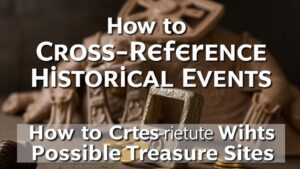Metal Detecting in Overgrown Battlefields for Forgotten Relics
Metal Detecting in Overgrown Battlefields for Forgotten Relics
Metal detecting in overgrown battlefields offers a unique opportunity to uncover fragments of history that have long been concealed beneath the earth. These battlefields, often shrouded in vegetation and time, serve as last resting places for artifacts associated with significant historical conflicts. As we delve into this topic, we will explore the methodology, legal considerations, and the rich rewards of metal detecting in these storied terrains.
The Historical Significance of Battlefields
Battlefields are crucial archaeological sites that contain remnants of past conflicts. Each relic has the potential to tell a story–whether it be a soldier’s personal item, weaponry, or even everyday items that illustrate the human experience during warfare. For example, the American Civil War resulted in the loss of over 600,000 lives, leaving behind countless artifacts like bullets, buttons, and personal items. The preservation of these artifacts helps to foster a greater understanding of historical events and their impacts on society.
Choosing the Right Equipment
The effectiveness of metal detecting in overgrown battlefields is largely dependent on the quality of the equipment used. Detectors that are specifically designed for relic hunting typically feature:
- High sensitivity to low-conductivity metals.
- Ground balance settings to adjust for mineralization.
- Discrimination capabilities to differentiate between target types.
For example, the Minelab Equinox 800 offers multi-frequency technology that allows users to detect various types of metal simultaneously, making it well-suited for the diverse composition of battlefield terrains.
Techniques for Navigating Overgrown Areas
Navigating overgrown battlefields poses unique challenges, including dense vegetation, uneven terrain, and the possibility of hazardous materials. Employing specific techniques can make the search more fruitful:
- Start in clearings or areas with less vegetation, which were historically used for troop movements.
- Use a handheld trowel for digging in hard-to-reach spots, being careful not to damage artifacts.
- Employ a systematic grid pattern for thorough coverage of the area, which can help ensure that no potential artifact goes unnoticed.
One notable technique involves utilizing a pinpointer–an accessory that allows the user to locate the exact position of the buried relic more efficiently, thus minimizing the disruption of the surrounding soil.
Legal and Ethical Considerations
Engaging in metal detecting on battlefields comes with a set of legal and ethical responsibilities. Many countries and regions have specific laws governing the excavation of artifacts from historic sites. It is critical to:
- Research local laws pertaining to metal detecting and artifact recovery before beginning.
- Obtain necessary permissions, especially if detecting on private land or protected sites.
- Follow ethical guidelines, such as reporting significant finds to local archaeological authorities.
In the United States, the Archaeological Resources Protection Act (ARPA) mandates that individuals cannot disturb archaeological sites without legal permission. Adhering to these regulations not only preserves history but also maintains the integrity of the metal detecting community.
Case Studies: Successful Finds
Numerous metal detecting enthusiasts have made remarkable discoveries in overgrown battlefields. For example, in 2018, a detectorist in Gettysburg, Pennsylvania, unearthed a rare Confederate belt buckle, providing insight into the lives of soldiers from that era. Similarly, metal detecting hobbyists in England have discovered World War I artifacts, including trench knives and medals, that have greatly contributed to public understanding of that conflict.
The Personal Rewards of Relic Hunting
The practice of metal detecting in overgrown battlefields is more than just a quest for valuable finds; it is also about connecting with history on a personal level. Many enthusiasts regard this hobby as a form of time travel, where each shovel of dirt brings them closer to the lives of those who came before. Beyond the thrill of discovery, individuals often form bonds with fellow detectorists, sharing experiences and knowledge that enrich their understanding of historical narratives.
Actionable Takeaways
For those interested in engaging with history through metal detecting in overgrown battlefields, consider the following steps:
- Research the history of the battlefield you intend to explore.
- Invest in quality equipment and familiarize yourself with its operation.
- Learn and adhere to local laws regarding metal detecting to avoid legal issues.
- Join local metal detecting clubs for support and camaraderie.
- Document your findings and share them with local historical societies or online communities.
As you embark on this journey, remember that every relic bears a story waiting to be told, and it is through responsible metal detecting that we can uncover and honor those forgotten narratives.


